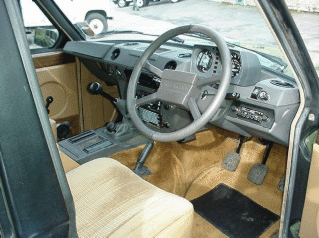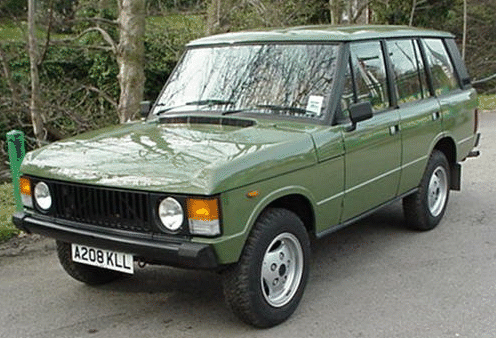|
MODEL TESTED: Five-speed, four-door, 3.5-litre V8-cyl ohv enqine 125 bhn (PS-DIN).
FOR:
Fuss-free cruising ability
Excellent off-road capability
AGAINST:
Poor fuel economy
THE MANUAL transmission has always been the least refined aspect of the Range Rover. It had to be a rugged gearbox to cope with the high torque loads in sustained low ratio work in arduous off-road conditions, so the well-tried Land Rover unit with its incorporated transfer box was the obvious - if rather agricultural -choice. Hence the luxurious Range Rover, with its so-refined all-alloy V8 engine and super-compliant suspension inherited this long, spindly gear shift lever and distinctly Vintage change quality, clunky and requiring long, deliberate movements. There was also quite a lot of driveline "shunt" and quite obtrusive gear whine. This has now changed. The gearbox is an adapted version of the 77mm Rover unit, strengthened and with altered ratios, driving through the recently-developed separate LT 230 R transfer box. Together these more modern, mechanically more refined gearboxes give the Range Rover the smoother, quieter transmission it has always deserved. The gear shift lever is shorter, has reduced throw and has a much more positive change quality, so the Range Rover is immediately more car-like to drive.
As part of their continuing programme of general improvements, Land Rover have added central door locking, a useful central console and a counterbalance system on the tailgate as standard equipment on the Range Rover, which is now available in either two- or four-door form and with either the five-speed manual of three-speed automatic (Chrysler Torqueflite) transmissions. Improved mechanical refinement is not the only advantage of the five-speed gearbox. Bener spacing of the ratios means improved mid-range performance and the higher, overdrive, top should give bener fuel economy. The better nerformance was immediately noticeable, but the improvement in economy was more elusive.
Land Rover Ltd. claim 10 per cent better consumption, but our overall test figure of 15.4 mpg is worse than the 16.2 mpg we recorded from the four-speed model we tested in October 1981. The overall figure could be misleading, since we did subject the five-speed to a lot of low-ratio, off-road work during which consumption dropped to 8.4 mpg. On the road, however, the best interim figure we recorded was 17.6 mpg, which is still not 10 per cent better than the average recorded with the four-speed. It cannot be denied that the potential for fuel saving is there if good use is made of the overdrive top gear; it is also obvious that economy does not suffer much in return for the striking improvement in performance.

Top speed of the five-speed is very similar to that of the four-speed - a maintainable mean maximum of 96 mph (95 mph for the four-speed) - but mid-range acceleration is much better. Getting from 30 mph to 50 mph takes 9.9 sec in fourth (13.6sec in the four-speed) and 6.8 sec in third (7.9 sec); the 50-70 mph time in fourth is nearly 4 sec faster. In pitching second, third and' fourth gears lower than in the four-speed box, Land Rover have deprived the Range Rover of an "ideal" top gear. The maximum speed of 96 mph comes up at 4.800 rom in fourth, 800 rpm over the peak power speed. Shifting into fifth has top speed wasting away slightlyto 95 mph, at 3,600 rpm, 400 rpm below the power peak. The intention obviously is for the lower gearing to give the better mid-range performance rather than pitch fourth a little higher in the hope of improving a top speed which is already considerably over the maximum permitted limit in this country.At the same time fifth becomes a near-perfect cruising gear, since 70 mph comes up at 2,700 rpm, only 200 rpm over the peak torque speed.
The Range Rover is a big, tall, cumbersome-looking car, but it is not a heavy beast to drive thanks to the pleasingly weighted power-assisted steering. Parking manoeuvres require little more than fingertip pressure, but assistance reduces with speed so that a firm hand is needed in fast cornering.
The recirculating ball steering lacks feel and is a little vague around the straight-ahead position, which calls for some care when threading through traffic on narrower country roads. The lack of feel is built in on purpose, to isolate the driver from the sort of shocks and kick-back that could be transmitted through the steering when the car is driven over rutted or rocky terrain. That lack of feel does not prevent the Range Rover from being placed and held accurately in corners. One of the car's more impressive features is its roadholding - straight line stability is excellent, and the car can be thrown into corners much faster than drivers new to the Range Rover would believe possible.
There is a lot of cornering roll, which can be unnerving to the inexperienced. The roll is again a by-product of the car's off-road alter ego - it has long-travel suspension unencumbered by anti-roll bars allowing it to cover tortuous terrain with ease. However, the roll does not impair the car's cornering ability. The body may tilt until suspension movement is taken up, but the live axles stay parallel to the road to ensure thoroughly predictable handling. Having said that, cornering in extremis can have an inside front wheel lifting, as our illustration shows, but even in this situation the driver is aware only of quite manageable levels of understeer. In less extreme cornering the combination of permanent four-wheel drive and near 50-50 weight distribution results in pleasantly neutral handling.

Reduced levels of gear whine now make the Range Rover a very comfortable long-distance cruiser indeed, since other sources of noise are well subdued. The lack of wind noise is particularly impressive considering the car's bulky shape; there is some hiss and roar from around the A-posts, but this does not become obtrusive until well above 70 mph. It is only to be expected that the big, coarse-treaded M+S tyres will generate some road noise, but again this does not become obtrusive until quite high cruising speeds are reached. With fifth gear engaged at 70 mph on the motorway it is possible to chat to rear seat passengers without raising the voice.
Inside the Range Rover retains its unexpected levels of elegance, with cloth upholsterv and roof lining and fully carpeted floor -including the luggage compartment. Even the spare wheel, mounted upright in the rear compartment, is carpet-covered. The hydraulic bottle jack and a comprehensive tool kit are also stowed under carpeted panel covers.
Instrumentation remains the same - comprehensive as befits a vehicle which could be called into service as an off-road workhorse - including the odd siting of the clock and oil pressure gauge in the heater console, low and on the passenger side. Interestingly, with all its luxury, the Range Rover still does not have recline adjustment for the front seats; perhaps it does not need it, since the seats proved comfortable and supportive enough, and there is plenty of head and legroom for six-footers with the seats as they are.
Our test car had most of the available extras, such as air conditioning, rear seat belts, alloy wheels and metallic paint. Three option packs are offered: Pack C adds front and rear armrests, rear head restraints, wood door cappings and loadspace carpets for a total of 367.52. Pack B adds the alloy wheels and metallic paints for 996.67, and Pack A throws in the air conditioning bringing the total added to 1,899.90 Pounds.
Taking advantage of the option pack can save money. In our price list accompanying this report the options are individually priced, putting the overall cost of the car up to 18,200. However, add the Option Pack A price to the basic and you get a very well equipped Range Rover for 17,273 Pounds. FUEL CONSUMPTION
Overall mpg: 15.4(18.3 litres/100km) 3.4 mpl
Hard 13.9 mpg
Average 16.9mpg
Gentle 20.1 mpg
Grade of fuel: Premium, 4-star (98 RM)
Fuel tank: 18 Imp. galls (82 litres)
Mileage recorder reads: 0.4 per cent short
ENGINE
Longways four-wheel drive.
Head/block Al. alloy/alloy. 8 cylinders in 90 deg V,
dry liners,5main bearings. Water cooled, viscous fan.
Bore, 88.9mm (3.Sin.), stroke 71.1 mm (2.8in.),
capacity 3,528 c.c. (215 cu. in.)
Valve gear ohv, hydraulic tappets,
chain camshaft drive. Compression ratio 9.35 to 1.
Contact breaker ignition,
2 Zenith-Stromberg 175 CD-SE carburettors.
Max power 125 bhp (PS-DIN) (93.2kW ISO) at 4,000 rpm.
Maxtorque l90 lb.ft. at 2,500 rpm.
SUSPENSION
Front, Live axle, radius arms, Panhard rod,
coil springs, telescopic dampers. Rear, Live
axle, radius arms, Pan hard rod, coil springs,
telescbpic dampers plus self-levelling strut.
STEERING
Recirculating ball, power assistance.
Steering wheel diameter l7in., 3.5 turns
lock to lock.
BRAKES
Dual, separate circuits. Front 11 .8in.
(300mm) dia discs. Rear 11 .4in. (290mm)
dia discs. Vacuum servo. Handbrake,
centre lever acting on transmission.
WHEELS
Al. alloy (steel standard), 6in. rims.
Michelin XM+Styres, size 205R-16 radial,
pressures F25 R25 psi (normal driving).
TRANSMISSION
Five-speed manual.
clutch 10.5 in. dia. Single dry plate
Gear Ratio mph/1,000rpm
Top 0.77 25.8
4th 1.00 19.8
3rd 1.4 14.2
2nd 2.13 9.3
1st 3.32 6.0
Final drive gear Hypoid bevels, ratio 3.54.
Transfer box: high 1.192 low 3.32
|

